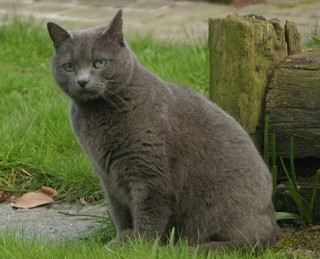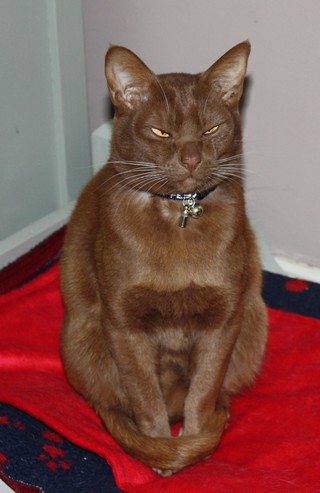Developing an ethogram
The aim of an ethogram is to recognise and define behaviours in which an animal undertakes. An example of how a behaviour is defined in an ethogram is given below for the example of a cat sitting: “SITTING – Cat is positioned with its front legs extended straight, front paws and rump on the ground” (Ellis and Wells, 2010, p.58). This example demonstrates the specificity of information used in an ethogram. To be able to measure a change in behaviour, the behaviours must be defined to ensure that others know what behaviour was being observed and could identify the same behaviours in another animal or at another time point if so desired, i.e. ensuring reliability. It is also useful to generate some common terminology to be able to compare between tests, i.e. if one study refers to resting, one study refers to an animal lying down and one refers to the behaviour as sleeping, this limits the value of the research and can cause confusion. Therefore it is most useful to ensure that there is common terminology between individuals. EXAMPLE: The following photographs illustrate cats in the sitting position. However, note how the posture of each cat is slightly different. For example, note the position of the tail; in one photograph the tail is wrapped around the front legs and in another it is extended away from the body. However both cats would be described as sitting.
An ethogram can be a general, all encompassing catalogue of behaviours of a species. For example, the study by Ellis and Wells (2010) developed and utilised an ethogram of general cat behaviour to assess the effects of olfactory stimulations such as lavender and catnip on cats housed in a rescue shelter. They can also be more context specific where lists and descriptions of behaviours are focussed around a particular behavioural theme or category, for example feeding. This specificity helps to avoid unnecessary information being observed which can complicate analysis, and helps to incorporate the large variation between contexts and individuals (Plowman, 2010). This style of ethogram is most useful when looking at particular events or interventions. One example of this in use is a study on dogs by Cracknell and Mills (2008) which looked at the effect of a homeopathic intervention on canine firework phobias. Changes in a group of behaviours involved in anxiety including panting, elimination and cowering were examined before and during firework periods within the subjects. Producing an ethogram from the baseline assessment allowed the study to assess for changes in these anxiety and fear related behaviours in order to identify whether the homeopathic remedy made a difference to the dogs behaviour. Examples of published ethograms include ‘Cat Behaviour Described’; the online ethogram resource provided by the University of Lincoln (see http://www.learnaboutcats.co.uk), and the Equid Ethogram produced by McDonnell (2003). TASK: The following two video clips illustrate two commonly observed types of behaviour, grooming and playing. Prior to watching both video clips, try to list all the behaviours you think cats may exhibit during grooming and playing. Then watch the videos and consider the following:
Help can be gained from ‘Cat Behaviour Described’.
When producing an ethogram, behaviours can be classified as either states or events in order to distinguish what mode of measurement will be required (Plowman, 2010). A state will generally have a long and measurable duration (Plowman, 2010), such as resting, walking or as a more specific example, a horse grazing. An event will be a short duration, i.e. equal to a snap shot in time such as yawning, sneezing or blinking (Plowman, 2010). It can be useful to distinguish between these if we want to measure behaviour efficiently as different measurement techniques tend to be used for each type of behaviour. It is also important to consider the type of data to be analysed. Information can be obtained in the form of qualitative or quantitative data. Qualitative data is data which has a discrete meaning or cannot be described as a quantity (Taylor, 2010a), for example a dog may be eating, drinking or resting. Defining between which behaviours the animal is performing is qualitative data. However, if you were asking the question how many times each of these behaviours were performed in a week, this would be quantitative data. If we described a dog’s bark as quiet or loud, or aggressive or friendly, such descriptions would be considered qualitative Quantitative data contains numerical value (Taylor, 2010b), such as ‘the dog ate 9 pellets of dry food’, ‘the horse ate its hard feed for 15 minutes’ and the cat sneezed 2 times. Quantitative data may also measure certain numerical information within a behaviour, such as measuring the volume of a vocalisation in decibels (Taylor, 2010b). TASK: For the following scenarios, state whether the behavioural outcome measures are quantitative, qualitative or both. Refer to the answers entitled “Quantitative vs. Qualitative” within the Answers page (under ‘Measuring Behaviour’) for answers. Scenario 1: A vet is interested in the food consumption of a recovering cat. He asks the owner to monitor whether the cat is eating less than normal, a normal amount or more than normal. The owner reports that the cat is eating less than normal so the vet advises the owner to weigh food given and food left to calculate the weight of food eaten. Scenario 2: A behaviour scientist is interested in behavioural variability within a litter in domestic dogs. When investigating confidence, she records how confident the puppies are on a scale of 1 to 10. Scenario 3: An ecologist is interested in migratory patterns in birds and records the name of the nearest city to each bird’s destination. In addition, he then calculates how far in km the birds have travelled. To produce an ethogram, the animal(s) should be observed for a pre-determined period of time (dependent on the species and the behavioural categories of interest) and all behaviours seen in this time period should be noted. These can then be defined in greater detail and should take in to account the different ways in which the same behaviours were observed, for example a cat may rest with its legs stretched out to the left or the right of its body but both positions constitute a resting posture. It is important to take a number of initial observations at different times and with different individuals. This ensures a variety of behaviours are observed prior to behaviour recording and that individual variation in behaviour is observed. For example, if the animal is only observed at a time of day when it will be sleeping, the ethogram will not be very comprehensive if a range of behaviours not only associated with sleeping are to be studied. There may also be seasonal effects on behaviour, for example cats may show more active behaviours such as predatory behaviours during spring and summer, as compared to autumn and winter (Fennell, 1975). In addition, different individuals may perform the same behaviour in descriptively different ways, for example, eating from a food bowl could differ across individuals from placing the mouth in the bowl to scooping the food out of the bowl using a paw. In summary, an ethogram is an essential tool to be made use of prior to undertaking formalised behaviour observations which gives a clear identification guide for behaviour. Ethograms can be very context specific or can be a catalogue of a range of general behaviours. Once preliminary observations have been conducted and an appropriate ethogram has been selected and produced, behaviour recording can begin. |
|||||||||||||

Compiled by:
Dr Sarah Ellis and Dr Helen Zulch



